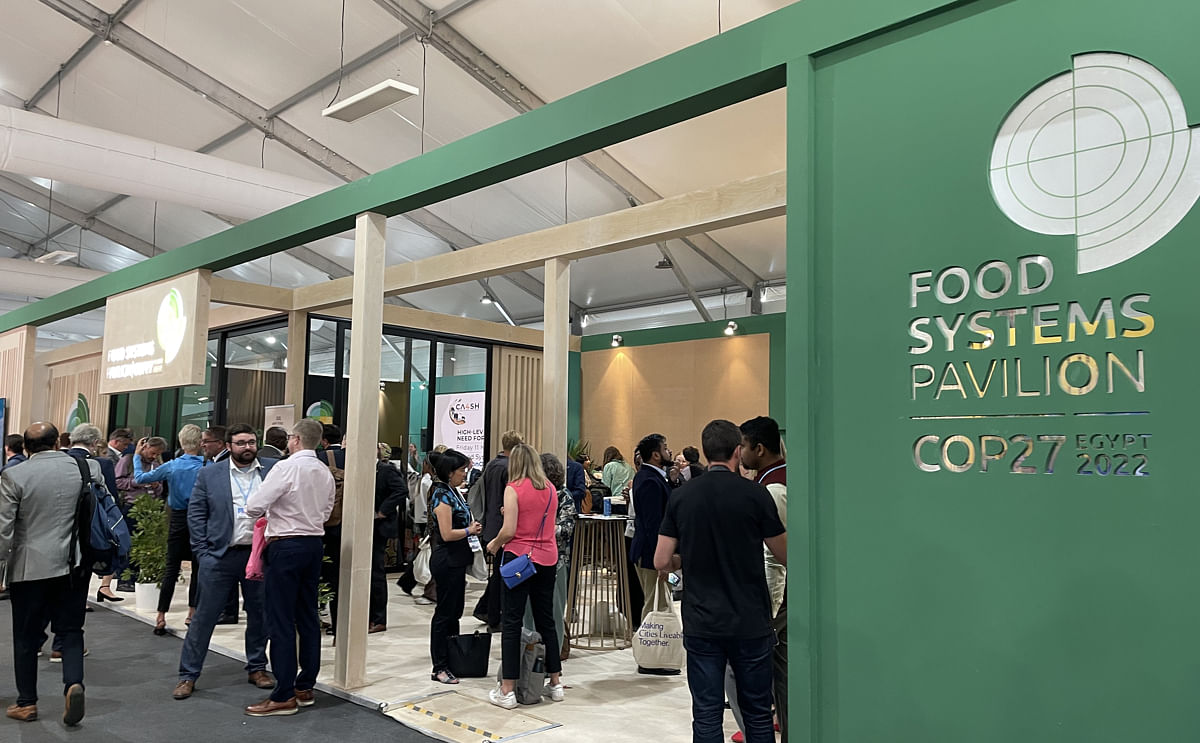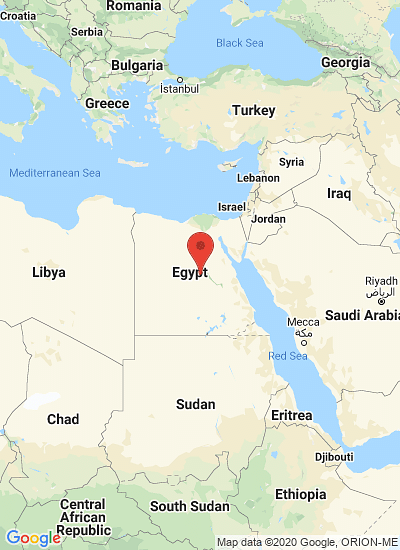The food pavilion at COP 27 hosted panels, conversations and presentations about the food systems impact on the climate crisis. (Courtesy: GreenBiz)
Food Systems in the spotlight at COP27 climate action negotiations

For the first time, food and agriculture systems have taken center stage in the global negotiations. This COP has been a breakthrough moment for food systems.
No matter where the official negotiations will land, organizers should be incredibly proud of having advanced the global recognition of food and agriculture as both a climate culprit and solution.
Building unstoppable momentum
João Campari, global leader of WWF’s food practice:
Different aspects of COP that happen at the same time.
First, there are high-level negotiations where heads of states, ministers and other delegates discuss the implementation of the Paris Agreement.
For the first time, one negotiation day focused entirely on agriculture. However, going beyond production to tackling emissions along the entire food value chain is still needed in those conversations, but it was an essential first step.
Second, there is the COP of side events. Countries and organizations host hundreds of panels and workshops, which creates the feeling of a giant buzzing world fair where everyone is discussing different aspects of climate action.
This year, food was all over those discussions. Five event spaces ("pavilions" in COP language) in the Blue Zone focused entirely on food and agriculture. Many other pavilions also integrated food and agriculture-related sessions into their programming.
While what happens in those side events is primarily talk, these conversations are critical to embedding food systems thinking into mainstream climate action, alongside energy, transportation, buildings and so forth.
Deborah Bossio, lead scientist for food systems at the Nature Conservancy:
These informal encounters provide an essential sense of hope and solidarity that helps organizations align efforts and stay energized in what can often feel like a slow and frustrating movement.
Gunhild Stordalen, founder and executive chair of EAT:
Concrete steps towards food systems transformation
In addition to these successes for food systems awareness and coalition building, COP27 also brought about significant announcements.
The Food and Agriculture for Sustainable Transformation (FAST) initiative aims to unlock climate finance to decarbonize and increase the resilience of food and agriculture sectors, especially in the world’s most vulnerable communities.
The Initiative on Climate Action and Nutrition (I-CAN) recognizes the relationship between nutrition and the climate crisis — representing a significant breakdown of siloes between food, agriculture, climate and nutrition groups. It will work to guide governments, financial institutions and the food industry toward shared goals.
Complementing these multilateral launches, an $18 trillion coalition of investors led by Jeremy Coller’s FAIRR Initiative successfully mobilized the UN Food and Agriculture Organization (FAO) to establish a climate roadmap for the food and agriculture sector by next year’s COP.
It will outline how the industry can stay within a 1.5°C pathway, be climate-resilient and address nature and food security goals.
Jeremy Coller:
No matter where the official negotiations will land, organizers should be incredibly proud of having advanced the global recognition of food and agriculture as both a climate culprit and solution.
Building unstoppable momentum
João Campari, global leader of WWF’s food practice:
"We can phase out fossil fuels, but we can’t phase out food, so we have to transform food systems. We’re today where energy was 30 years ago, yet we don’t have 30 years to make the change."We should remember that food has only made its grand debut with the United Nations at last year’s Food Systems Summit. Mere 14 months later, food systems thinking has extensively penetrated COP27.
"This is very true. But seeing how quickly food has been taking the stage, I’m not worried about waiting for 30 years until we get to its transformation."
Different aspects of COP that happen at the same time.
First, there are high-level negotiations where heads of states, ministers and other delegates discuss the implementation of the Paris Agreement.
For the first time, one negotiation day focused entirely on agriculture. However, going beyond production to tackling emissions along the entire food value chain is still needed in those conversations, but it was an essential first step.
Second, there is the COP of side events. Countries and organizations host hundreds of panels and workshops, which creates the feeling of a giant buzzing world fair where everyone is discussing different aspects of climate action.
This year, food was all over those discussions. Five event spaces ("pavilions" in COP language) in the Blue Zone focused entirely on food and agriculture. Many other pavilions also integrated food and agriculture-related sessions into their programming.
While what happens in those side events is primarily talk, these conversations are critical to embedding food systems thinking into mainstream climate action, alongside energy, transportation, buildings and so forth.
Deborah Bossio, lead scientist for food systems at the Nature Conservancy:
"This is huge the inclusion of food and agriculture in these two aspects of COP27. It acknowledges that without transformations of food systems, which account for approximately one-third of global greenhouse gas emissions and the vast majority of biodiversity loss, we will be unable to achieve a stable climate, feed people and save biodiversity."Third, there’s the COP of meetings, hallway chats and dinners where people across organizations and countries strategize and form partnerships. Again, most of this just manifests as talking at the summit, but there will be a lot of follow-up and collaboration once folks get home.
These informal encounters provide an essential sense of hope and solidarity that helps organizations align efforts and stay energized in what can often feel like a slow and frustrating movement.
Gunhild Stordalen, founder and executive chair of EAT:
"Progress always starts with discussions that then get translated into action. Yes, we’re not moving fast enough, but at the same time, we’re experiencing unstoppable coalition building to actually move things forward."EAT has been one of the cornerstone organizations in accelerating food systems transformation over the past years.
Concrete steps towards food systems transformation
In addition to these successes for food systems awareness and coalition building, COP27 also brought about significant announcements.
The Food and Agriculture for Sustainable Transformation (FAST) initiative aims to unlock climate finance to decarbonize and increase the resilience of food and agriculture sectors, especially in the world’s most vulnerable communities.
The Initiative on Climate Action and Nutrition (I-CAN) recognizes the relationship between nutrition and the climate crisis — representing a significant breakdown of siloes between food, agriculture, climate and nutrition groups. It will work to guide governments, financial institutions and the food industry toward shared goals.
Complementing these multilateral launches, an $18 trillion coalition of investors led by Jeremy Coller’s FAIRR Initiative successfully mobilized the UN Food and Agriculture Organization (FAO) to establish a climate roadmap for the food and agriculture sector by next year’s COP.
It will outline how the industry can stay within a 1.5°C pathway, be climate-resilient and address nature and food security goals.
Jeremy Coller:
"The roadmap will provide much needed clarity to both companies and investors, which will allow companies to plan for the transition and investors to assess investment risk and opportunities."Helena Wright, policy director at the FAIRR Initiative:
"Investors will be looking for the roadmap to include clear guidance on methane emission limits, halting deforestation, scaling up alternative protein production and support to ensure a just transition for farmers."
"Even though the roadmap will help provide incentives, it’s not an excuse for inaction now. The science on the food system’s impact on nature and climate is already clear, and companies do not need to wait for a roadmap to improve their policies."
Like to receive news like this by email? Join and Subscribe!
Get the latest potato industry news straight to your WhatsApp. Join the PotatoPro WhatsApp Community!
Sponsored Content
Sponsored Content
Sponsored Content
Sponsored Content








